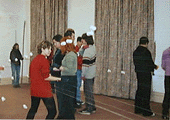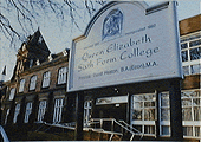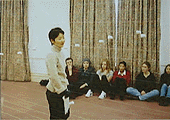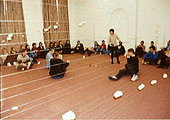水嶋一江は、The Japan Festival Educational Trustの企画により、1999年1月27日から2月4日にかけて、イギリスのダーリントンにある、Queen Elizabeth Sixth Form Collegeで、ストリングラフィのワークショップを行いました。対象者は、カレッジの在校生、近隣の高校生、小学生などで、一週間で、300人近くの学生及び先生が受講しました。期間中、カレッジの一室が、ストリングラフィ・ワークショップのために提供され、ワークショップの最終2日間には、受講生+水嶋一江による、小コンサート(8回)が企画されました。また、アート・ファウンデーション・コースの学生によって、カレッジの中庭には、ストリングラフィの屋外インスタレーションが出現しました。これらの活動を通じ、在校生1600人がストリングラフィに触れる機会を持ちました。
|
Going from Strength to Strength with STRINGRAPHY |
In 1992, Japanese composer Kazue Mizushima created a new concept in musical expression with the invention of stringraphy, setting up sound installations made from numerous 'string telephones' (silk threads attached to paper cups) which transform the entire performance space into a giant instrument. Studio Eve, which she formed with two other members, has been developing works for String Telephone Ensemble since 1996, with with three to eight players playing a wide-ranging repertoire. The group has been invited to perform at museums in Japan and abroad, and has also set up installations in hospitals and office buildings, taking music to a wider audience. In 1996, Kazue Mizushima received awards for Stringraphy '96 from the International Society for Contemporary Music. She has recently spent ten days as Artist in Residence at Queen Elizabeth Sixth Form College in Darlington, working with pupils to explore the possibilities of stringraphy. We spoke to her to find out more about this unusual art.
|
| When did your interest in music begin? |
I started learning the piano from quite a young age, as many Japanese girls do, but I found practising very difficult and soon began to think that it would be more fun to compose my own music. I also had a vague idea that I would like to become a composer one day, without really knowing how to go about it. Eventually I decided to go to a music university, and studied composition at Toho Gakuen. While still at high school, I had developed an interest in contemporary music, and was also attracted to other forms of art, such as films, dance and theatre. I began to think of music in a wider context, but when I got to university, I found the approach very conservative, with a lot of emphasis on technique. We were learning to compose music exclusively for western instruments such as the piano and the violin, instruments which were developed in 19th century Europe to reflect the aesthetics of a particular time and place. I felt that as a Japanese person in the 20th century, I would like to be able to compose music for a new instrument more suited to my own context.
|
| What experience did you gain from studying in the States? |
When I graduated from university, computer music was still quite a novelty in Japan, and as computers keep on changing and developing and are a product of the modern era, I thought they might be the kind of instrument I was searching for. So I studied in California for two years, but although I took a Masters Course in Composition, many of the students had degrees in Computer Science rather than in Music, and were more familiar with a computer keyboard than a piano keyboard. The approach to music was quite scientific - we would try to discover why certain sounds appeal to the human ear, for example - and I leant a lot which came in useful later, but ultimately I decided that the computer was not the right form of expression for me.
|
| How did you come to invent stringraphy? |
By a process of trial and error, really. At first, I tried to play traditional instruments in non-traditional ways, such as opening the lid of a piano and playing the strings, or walking around the room while playing a violin, but I found that after you have done that kind of thing once, there is little room for development, because the instruments were designed for a different purpose. I also experimented with sounds such as water drops, but didn't get much response. Then at a performance festival in the woods, which took place soon after I returned to Japan, I decided to tie lots of threads from tree to tree to see what kind of sound I could produce. This proved to be interesting because the many threads criss-crossing each other also had a strong visual impact, and since the instrument was so large, I could sway from side to side while playing it, creating a dance-like effect.
|
| How did people react to this new concept in music? |
On the whole, contemporary art and music tends to be quite exclusive, and so there is not usually much response from the general public. But I found that with stringraphy, people showed a lot of interest, which may have been due to the familiarity of the 'string-telephone' (ito-denwa), as children often play with this in Japan, and it's also used in physics experiments at primary school. Suddenly I had television journalists wanting to interview me, perhaps because my installations had a strong visual impact, which is not usually the case with musical instruments. When they asked me to play a familiar tune, I refused at first, feeling that there was no point in playing conventional music on a newly created instrument. But every single person who interviewed me made the same request, until eventually I thought I should at least try it. As it was around Christmas, I played a carol for a live broadcast at 7am. I hadn't yet developed a tuning system, so I don't think it came out very well, but I began to think it might be interesting to try to play different kinds of music. Strangely enough, in all the years I had learnt the piano, it had never occurred to me to play anything other than classical music on it. I was keen for a broad range of people to hear my music, and when I asked for feedback after performances, most people said that the part they most enjoyed is when I played their favourite songs. So, I have played everything from Vivaldi to the Beatles, including gagaku music, is well suited to the sound produced by stringraphy installations.
|
| Can you tell us about your residency at Queen Elizabeth 6th Form College? |
 Although I had done concerts and workshops at universities in Japan and Canada, it was quite a new thing for me to spend as long as ten days in one school. I started working with 30 students on the Art Foundation Course, who came up with the idea of setting up an installation in the school courtyard.
Rita Smith, who co-ordinated the project, then brought in some first years who were studying painting, and they turned out to be particularly
interested in the musical side. Their efforts inspired the others, and we
decided to form a small ensemble group, which gave concerts and workshops in breaks and lunch times. We made a record of everyone's impressions on tape, and transferred some comments onto slides which were then used to make a small installation. I think most of the 1600 pupils at Queen Elizabeth had some kind of exposure to the project by the end of my stay, and we also had visits from from three or four high schools and a primary school. What made the residency so productive was that each student approached stringraphy from a different perspective, and brought their own particular interests to it. Although I had done concerts and workshops at universities in Japan and Canada, it was quite a new thing for me to spend as long as ten days in one school. I started working with 30 students on the Art Foundation Course, who came up with the idea of setting up an installation in the school courtyard.
Rita Smith, who co-ordinated the project, then brought in some first years who were studying painting, and they turned out to be particularly
interested in the musical side. Their efforts inspired the others, and we
decided to form a small ensemble group, which gave concerts and workshops in breaks and lunch times. We made a record of everyone's impressions on tape, and transferred some comments onto slides which were then used to make a small installation. I think most of the 1600 pupils at Queen Elizabeth had some kind of exposure to the project by the end of my stay, and we also had visits from from three or four high schools and a primary school. What made the residency so productive was that each student approached stringraphy from a different perspective, and brought their own particular interests to it.
|
| In what direction would you like to develop stringraphy from now on? |
I think the residency in Darlington has made me even more conscious of how many possibilities there are for using stringraphy and I now feel inspired to explore other directions it might develop in. I think it is important to experience stringraphy first hand and so I would like to perform in as many different venues as possible. The experience in Britain has made me realise that even people who have never studied music can express themselves beautifully through stringraphy.
("JAPAN" NO.63 March 9th, 1999)
|






 Although I had done concerts and workshops at universities in Japan and Canada, it was quite a new thing for me to spend as long as ten days in one school. I started working with 30 students on the Art Foundation Course, who came up with the idea of setting up an installation in the school courtyard.
Rita Smith, who co-ordinated the project, then brought in some first years who were studying painting, and they turned out to be particularly
interested in the musical side. Their efforts inspired the others, and we
decided to form a small ensemble group, which gave concerts and workshops in breaks and lunch times. We made a record of everyone's impressions on tape, and transferred some comments onto slides which were then used to make a small installation. I think most of the 1600 pupils at Queen Elizabeth had some kind of exposure to the project by the end of my stay, and we also had visits from from three or four high schools and a primary school. What made the residency so productive was that each student approached stringraphy from a different perspective, and brought their own particular interests to it.
Although I had done concerts and workshops at universities in Japan and Canada, it was quite a new thing for me to spend as long as ten days in one school. I started working with 30 students on the Art Foundation Course, who came up with the idea of setting up an installation in the school courtyard.
Rita Smith, who co-ordinated the project, then brought in some first years who were studying painting, and they turned out to be particularly
interested in the musical side. Their efforts inspired the others, and we
decided to form a small ensemble group, which gave concerts and workshops in breaks and lunch times. We made a record of everyone's impressions on tape, and transferred some comments onto slides which were then used to make a small installation. I think most of the 1600 pupils at Queen Elizabeth had some kind of exposure to the project by the end of my stay, and we also had visits from from three or four high schools and a primary school. What made the residency so productive was that each student approached stringraphy from a different perspective, and brought their own particular interests to it.